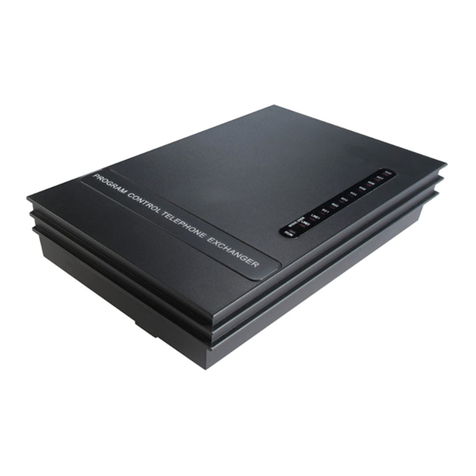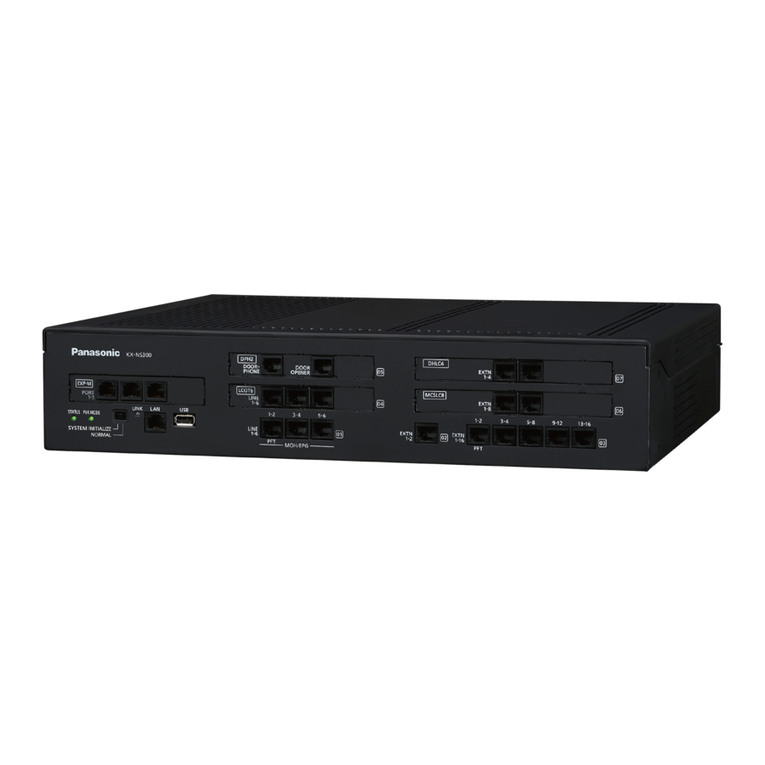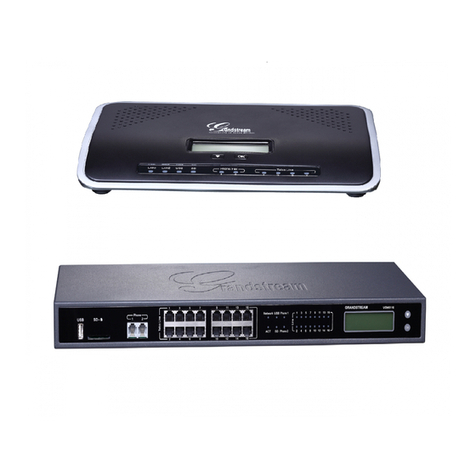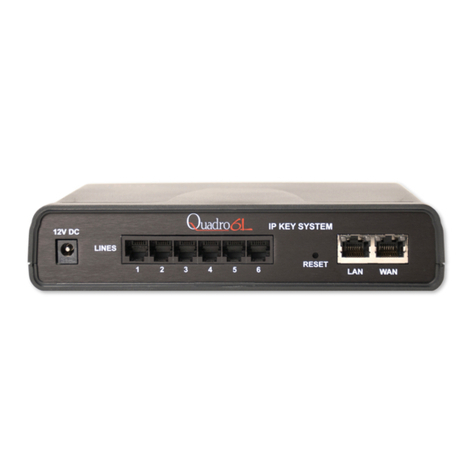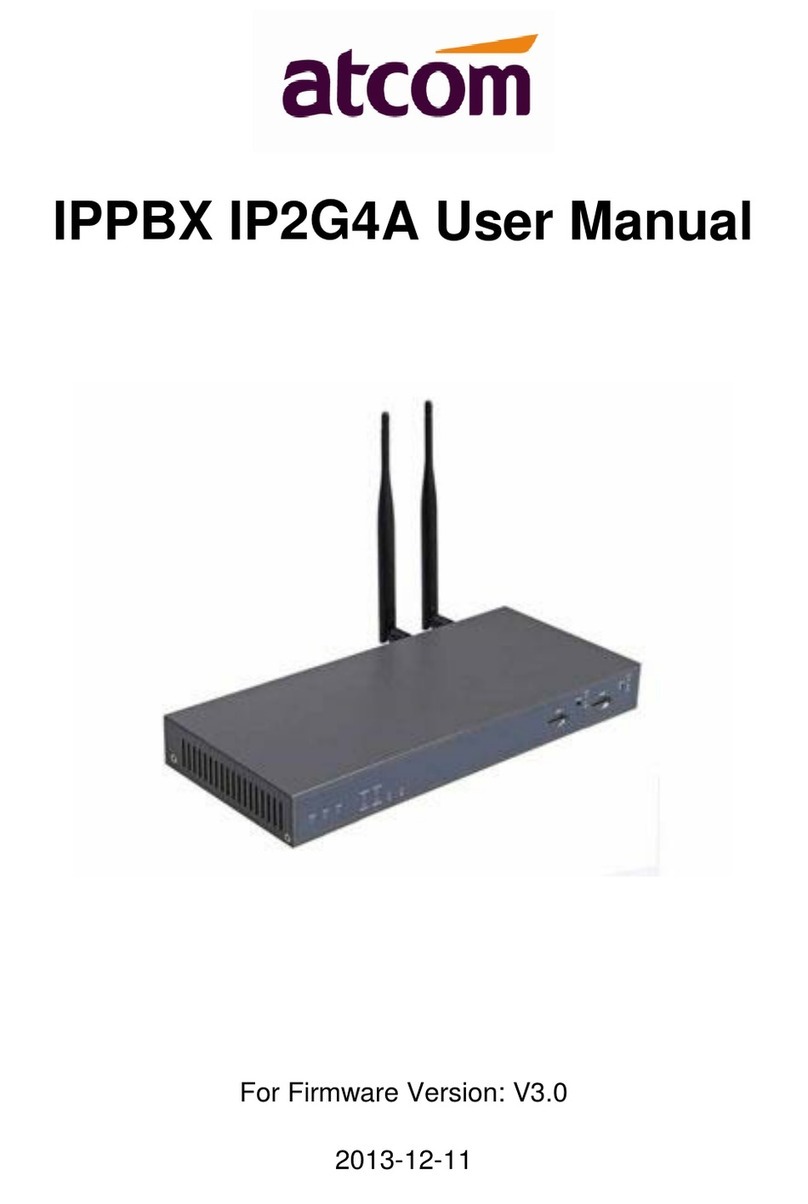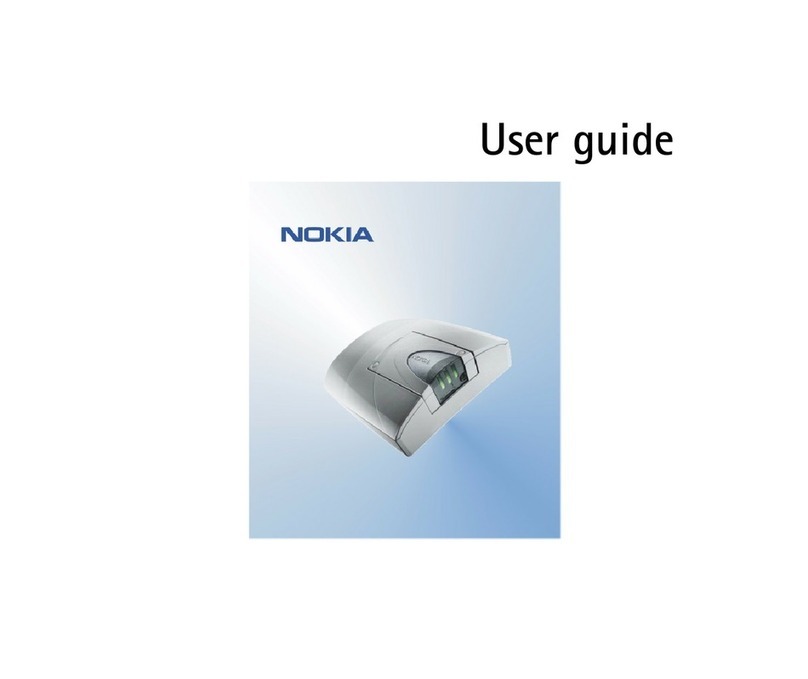Excelltel CDX-CS User manual


--------------------------------------------------------------------------
Table of Contents
CHAP 1 BRIEF INTRODUCTION & FEATURES...........................................................................1
1.1 SYSTEM OVERVIEW ................................................................................................................................... 1
1.2 FEATURES................................................................................................................................................. 1
CHAP 2 INSTALLATION & CONNECTION ...................................................................................3
2.1 SYSTEM CONFIGURATION ........................................................................................................................... 3
2.2 SYSTEM APPEARANCE................................................................................................................................ 4
2.2.1 CS /CS+ Plastic Series.................................................................................................................... 4
2.2.2 TS/TS+ Metal Series..................................................................................................................... 5
2.3 INSTALLATION PROCEDURE.......................................................................................................................... 5
2.4 INSTALLATION WARNING ............................................................................................................................. 7
2.5 DIRECT ACCESS WHEN POWER FAILURE ...................................................................................................... 7
2.6 EXTERNAL MUSIC INPUT ON HOLDING.......................................................................................................... 7
CHAP 3 SYSTEM PROGRAMMING..............................................................................................8
3.1 BEFORE PROGRAMMING ............................................................................................................................. 8
3.2 BASIC COMMAND....................................................................................................................................... 9
3.2.1 Enter into System Programming Status........................................................................................... 9
3.2.2 Change the Password..................................................................................................................... 9
3.2.3 System Soft-Reset........................................................................................................................... 9
3.2.4 Flash time setting ...........................................................................................................................10
3.2.5 System return to default setting......................................................................................................10
3.2.6 Setting Delay time for outgoing call transfer ................................................................................10
3.3 ENABLE/DISABLE C.O. LINES.....................................................................................................................10
3.3.1 Enable C.O. Lines ..........................................................................................................................10
3.3.2 Disable C.O. Lines..........................................................................................................................11
3.3.3 Trunk lines (C.O.lines) working assignment (UCD) ........................................................................11
3.4 SETTING OPERATING MODE .......................................................................................................................12
3.4.1 Setting Auto-attendant Mode (OGM) for C.O. Lines.......................................................................12
3.4.2 OGM busy Process in Auto-attendant Mode ..................................................................................12
3.4.3 Setting Operator Mode for C.O. line...............................................................................................12
3.4.4 CRBT (Directly ringing while play OGM Process in Auto-attendant Mode).....................................13
3.5 OGMRECORDING/MONITORING ................................................................................................................14
3.5.1 OGM Recording(For CS/TS Series)..........................................................................................14
3.5.2 OGM Monitoring(For CS/TS Series)..........................................................................................14
3.5.3 System Music Monitoring(For CS/TS Series)............................................................................14
3.5.4 OGM Recording(For CS+/TS+ Series).........................................................................................14
3.5.5 Monitoring the recorded OGM (For CS+/TS+ Series)...............................................................15
3.5.6 One paragraph OGM Mode (For CS+/TS+ Series)...................................................................15
3.6 PROCESS IN AUTO-ATTENDANT MODE.........................................................................................................15
3.6.1 No Dial Process..............................................................................................................................15
3.6.2 Called Extension Busy Process......................................................................................................15
3.6.3 Called extension No Answer Process.............................................................................................16
3.7 OPERATOR SETTING .................................................................................................................................16
3.7.1 Operator Setting.............................................................................................................................16
3.7.2 Fast Dialing Operator .....................................................................................................................16
3.8 OPERATOR ATTENDANT RINGING SETTING...................................................................................................17
3.8.1 Ringing mode when all the ringing extensions is busy ...................................................................17
3.8.2 Ringing Extensions Assignment/ to Cancel in Day mode...............................................................17
3.8.3 Ringing Extensions Assignment/ to Cancel in Night Mode.............................................................17
3.9 DIALING-OUT MODE SETTING.....................................................................................................................18
3.10 CALLING RESTRICTION SETTING...............................................................................................................19
3.10.1 Calling Duration Restriction Setting / Clear ..................................................................................19
3.10.2 Calling Restriction-Class Setting ..................................................................................................19
3.10.3 Calling Restriction Item.................................................................................................................20

--------------------------------------------------------------------------
3.10.4 Assign Special Calling-out Number for class 0.............................................................................21
3.11 EXTS.USING C.O.LINES ACCESS.............................................................................................................22
3.10.4 Assign Exts. Outgoing to Certain C.O. Line / to Clear in day mode..............................................22
3.10.4 Assign Exts. Outgoing to Certain C.O.Line / to Clear in night mode.............................................22
3.12 FLEXIBLE CODING ...................................................................................................................................22
3.13 RINGING/TRANSFER/RESERVATION TIME ...................................................................................................23
3.13.1 Internal Call Ringing Time ............................................................................................................23
3.13.2 Operator Dialing/Transfer Ringing Time .......................................................................................23
3.13.3 No Answer Transfer Time .............................................................................................................23
3.13.4 External Line Reservation Time....................................................................................................24
3.14 TRANSFER OPERATION PARAMETER .........................................................................................................24
3.14.1 External Transfer Mode ................................................................................................................24
3.14.2 External Transfer to a no answer Extension Process...................................................................24
3.14.3 Enable/disable Call Forwarding Settings reserved when Power Failure.......................................24
3.15 CID FUNCTIONS SETTING (FOR CS+/TS+ SERIES)....................................................................................24
3.15.1 Add digits for intercom CID...........................................................................................................24
3.15.2 Internal CID mode(transmit mode) setting....................................................................................25
CHAP 4 OPERATING INSTRUCTION.........................................................................................26
4.1ANSWERING CALLS AT OPERATOR MODE ......................................................................................................26
4.2ANSWERING CALLS AT AUTO-ATTENDANT MODE.............................................................................................26
4.3 DAY/NIGHT MODE MANUAL SETTING ..........................................................................................................26
4.4 SET &CLEAR OTHER EXT.CALL FORWARDING THROUGH PROGRAMMING EXTENSIONS ....................................27
4.5 OUTWARD DIALING ...................................................................................................................................27
4.5.1Outward Dialing Directly..................................................................................................................27
4.5.2 Outward Dialing by dialing outgoing code(9) first...........................................................................27
4.6 AUTOMATICALLY CALLBACK BUSY (BOOKING C.O. LINE)...............................................................................28
4.7 OUTWARD DIALING BYAN EXCLUSIVE LINE....................................................................................................28
4.8 OUTGOING CALL TRANSFER (SECRETARY FUNCTION)...................................................................................28
4.9 CALL PICKUP............................................................................................................................................29
4.9.1 Pick up a certain ringing Extension.................................................................................................29
4.9.2 General Call Pickup........................................................................................................................29
4.10 CALL TRANSFER (EXTERNAL CALL)...........................................................................................................29
4.11THREE WAY CONFERENCE.......................................................................................................................30
4.12 C.O. LINE RESERVATION..........................................................................................................................31
4.13 C.O. LINE TRANSFER TO C.O. LINE...........................................................................................................31
4.14 CALL SWITCH (CALL PICK DURING CONVERSATION) .....................................................................................31
4.15 CALL WAITING(R-KEY FUNCTION)(OPTIONAL).............................................................................................32
4.16 INTERCOM CALLING ................................................................................................................................32
4.16.1 Intercom calling at direct-dialing-out mode...................................................................................32
4.16.2 Intercom calling at indirect-dialing-out mode................................................................................32
4.17 CONNECT WITH OPERATOR DIRECTLY (FAST DIALING OPERATOR) ...............................................................33
4.18 INQUIRY FUNCTIONS (AUTOMATIC REPORTING)..........................................................................................33
4.18.1 Reporting of Physics Number.......................................................................................................33
4.18.2 Automatic reporting of Ext number ...............................................................................................33
4.19 PRIORITY ACCESS AND MONITORING.........................................................................................................33
4.20 MANAGER/SECRETARY FUNCTION(CALL FORWARDING DIRECTLY) ................................................................34
4.21 CALL FORWARDING WHEN EXT IS BUSY OR NOBODY AVAILABLE ..................................................................34
4.22 SETTING DON’T DISTURB /CLEAR ............................................................................................................34
4.23 CALLALL EXTENSION(EMERGENCY CALLING).............................................................................................34
4.24 CLEAR EXTENSION FUNCTION SETTING.....................................................................................................34
CHAP 5
MAINTENANCE & TROUBLESHOOTING................................................................35
1. Outgoing calls can’t be made ..............................................................................................................35
2. Outside calls can’t dial in .....................................................................................................................35
3. Intercom can’t be made .......................................................................................................................35
CHAP 6 GLOSSARY
...........................................................................................................37
CHAP 7 DEFAULT SETTINGS
........................................................................................38

--------------------------------------------------------------------------
CHAP 8 PROGRAMMING & OPERATION INSTRUCTION........................................................39
8.1 INDEX OF SYSTEM PROGRAMMING..............................................................................................................39
8.2 INDEX OF OPERATIONS..............................................................................................................................43

--------------------------------------------------------------------------
P1
Chap 1 Brief Introduction & Features
1.1 System Overview
With its design and manufacture according to G.712 and G.732 protocols of CCITT, the
system integrates virtues of various KTSs with advanced functions of PABX, and has unique
advantage in innovation.As a type of new generation with over 50 powerful functions for business
and management, it has wide application in offices, enterprises, hotels……etc. In a word, it is a
ideal equipment for users to better communication conditions, improve work efficiency, control call
fee payment, and make office intelligent come true.
1.2 Features
Normal phone programming:use normal phone programming, not need the specialized key
phone.
System CRBT Function:except for operator and auto-attendant mode, the system can play
the OGM without dialing any number. Connect with the computer, can record the promote
information of the and play it to customers. (same as the CRBT of ISP)
Operator Day/Night Mode: can switch the calling out class, calling in extension
and calling out C.O.line authority by user ’s requirement.
Mutiple Dial-Out Mode:Can choose dial-out number 9 or direct dial CO line.
Coming Call Prompt: When all the extensions are busy, if external line calling (including
door phone), the system will prompt the set ringing extension.
Difference of the ringing: internal call, external call and door phone call have different
ringing.
TransferCaller ID (CS+/TS+ Series): when CO.Line call in or other Extension call ,you can see
Cid number in telephone; also the incoming CID number will follow while call transferred.
Auto-attendant/Operator Mode: the incoming calls from C.O. lines can be set up the
operator mode or the auto-attendant mode freely.
Dial in/out Setting: can set any ringing extension and the using access of CO lines.
CO Line Booking: when the CO lines are busy but urgently to call, the system will prompt the
extension when CO line available.
CO Line Reservation: any extension can reserve the CO line and do others operations.
Three Way Conference and External transfer Function: allows to add a third party to a
two-party conversation and make a three-party conference. You can have only two Ext. with

--------------------------------------------------------------------------
P2
one C.O.line. And can make an outgoing call from one Ext then divert and connect other Ext
to C.O.line.
Call Transfer and Pickup: all external and internal calling can be transferred, other ext.
ringring can be picked up and not need answer the ringring ext. This system have many kind
of pickup ways, including exts. pickup, CO line pickup and reservation, etc.
Operator Function: This system can be set two operator for reservation, call forwarding, call
transfer and manager secretary.
External Call Switch (call pickup during conversation): during the conversation with CO
line, if other CO lines or door phone calling, just easy reserve the answering CO line and
pickup the calling call.
External Music interface:allow you to change the system holding music freely.(optional)
Flexible extension number:The number of extension can be set up one to four digits.
Power Failure Memory: when power failure, the system can remain all the settings and just
use all the functions when power again.
Remote control programming: It can sustain remote maintenance, process remote
control programming, detect and maintain, which facilitate the users to install and test, and
provide quick and effective service to users.

--------------------------------------------------------------------------
P3
Chap 2 Installation & Connection
Before Installation
For easy and quick installation and connection, it is strongly recommended that the user read
and follow the following instruction carefully so as not to damage the system accidentally by
incorrect operation.
2.1 System Configuration
This system capacity smallest is 208, biggest is 416.
This series PABX including basical series CS (plastic covers) and TS (metal covers), and
enhancement series CS+ (plastic covers) and TS+ (metal covers); CS and TS same functions,
CS+ and TS+ same functions. And TS+ series can be expanded wireless terminal board.
Model
CS /TS
CS+/TS+
CS208
TS208
CS308
TS308
CS312
TS312
CS416
TS416
CS+208
TS+208
CS+308
TS+312
CS+312
TS+312
CS+416
TS+416
CO Line Ports
2
3
3
4
2
3
3
4
Exts. Ports
8
8
12
16
8
8
12
16
DISA
10s one paragraph
20s three paragraphs
Music On
Holding
Piano music, external music input on
holding is optional
11 chord melody music, external music
input on holding is optional
Caller ID
External line caller ID
Transfer & internal caller ID
Please according to the capacity and functions of your machine when install
and program the system.

--------------------------------------------------------------------------
P4
2.2 System Appearance
2.2.1 CS /CS+ Plastic Series
①Power Indicator Light ②C.O.Line Indicator Light ③Ground Port
④308 C.O.Line Port ⑤308 Exts. Port ⑥416 C.O.Line Port

--------------------------------------------------------------------------
P5
⑦416 Exts. Port
2.2.2 TS/TS+ Metal Series
①Power Indicator Light ②C.O.Line Indicator Light ③Exts. Indicator Light
④C.O.Line Port ⑤Exts. Port ⑥Power Socket
⑦Power Switch ⑧External Music Interface
⑨Door Lock Interface(optional)
2.3 Installation procedure
Before installation, please check all the parts if have any looseness, take care the supply
power switch if is shut down.
The telephone exchange shall be installed in a stable indoor place with dry, ventilated
environment. (Temperature Range: 0-45℃, Humidity Range: 20%-80%.Avoid straight sun

--------------------------------------------------------------------------
P6
shine or in the environment of flammable or caustic gas.) Special telephone wire is
preferable.
A wall bore is available at the underside of mainframe for wall installation. Desk installation
is also admitted. But the contact of wall bolt and circuit board inside the mainframe should
be avoided.
None of the wiring of any extension should share the pipeline with power supply or antenna.
Neither should the extension be close to antenna for air broadcasting (including
short-wave).
For the sake of personal safety and communication quality, grounding of PABX should be
reliable. Or else, the lightning-proof device inside would fail to work.
Resistance to ground should be less than 10 ohm.
Grounding as follows:
Connect the monomer-crystal with EXT. line and C.O. line separately, use the normal
telephone to test the C.O.line if is ok.
Connecting extensions according to the in-dilated extension positions and C.O. lines to the
corresponding line ports on the unit.
Test the function of power failure transfer. Before power on, off hook the extension to test if
the telephone can dial out and check the wire again if can not dial.
Connected all the wires, take the power on and to see if the indicator light twinkling, if yes
that mean the system working.
Test the system according to the default settings.
Test the whole system to see if can be worked well, if not and then reset the system.

--------------------------------------------------------------------------
P7
2.4 Installation Warning
1. Please keep the exchange away from other equipment producing large electromagnetic
disturbance (such as motor and large transformer).
2. None of the wiring of any extension should share the pipeline with power supply or antenna.
Neither should the extension be close to antenna for air broadcasting (including short-wave).
3. Avoid damaging the power-supply cable. Keep it away from water. Encountering the leakage
of water cut off the power immediately.
4. Please don't impact or shake the exchange at any situation. Don't remove the exchange in
working status.
5. Avoid using telephone in thundering.
6. Please don't use the telephone in flammable and leaking gas environment.
7. Unless the equipment is disconnected, please don't touch the broken part of the wiring or any
connection ends.
● Note: Lightning stroke is an accident, which will not be regarded as normal maintenance.
2.5 Direct Access when Power Failure
The C.O. lines will be connected direct to the special Exts automatically when the power
failure. The No.1 C.O. line will be connected to Ext. 601 and No.2 to Ext.602, No.3 to Ext.603,
No. 4 to Ext.604. So you only can use the four Exts as normal phone with direct C.O. line.
For example when someone call in with No.1 C.O. line at the time of power failure, the
Ext.601 will ring, you can only pick up Ext. 601 and talk with the caller.
2.6 External Music Input on Holding
As the diagram on right, connect the external music with
the system music interface.
Note: when connected with the external music, system switch to the external music automatically.
If want to use internal music, should disconnect with the external music, otherwise will be no
music.

--------------------------------------------------------------------------
P8
Chap 3 System programming
The system has the initialize settings when left factory, user can use it normally when
installed and connected well, don’t need refer this chapter; if user want to change some settings,
that should be refer this chapter.
3.1 Before programming
●Trunks mean telephone line from local ISP, connect with the PABX port C01-C04, also called
C.O.Lines; User Lines mean the line which connect with the PABX port 601-616, also called
internal line, the connected telephone called extension.
●All the extensions must be of dual tone multi-frequency phone.All the programming must be
carried out on the extension 601, 602, 603, 604; all the programming must be into system
programming status.
●When the setting is finished, a long beep indicates that the setting is done correctly and
saved in the system. If instead an array of short chirps is heard, that would indicate an error
occurred in the setting. You need to check it out and reset the system. It is only after the end
of the long beeps you can continue another system operation.
●You are allowed to operate one by one, and end the process by simply pressing #. You don’t
have to hang up if something wrong occurs, you could press * to restart.
●If programming-extension (601,602,603,604) is in Direct-Dialing-Out mode, you need to
press * to enter the internal system, then start programming.
●You must use “enable C.O. lines” command according the actual trunk lines before using
this product, if you don’t enable any C.O. line, the system will consider there is no C.O. line
and doesn’t auto detect C.O. line.
●The functions which is optional in this user manual, that mean just some models have the
function, please be sure your model and then can know if your machine has that functions.
●CS308/TS308 are the same programming format with CS416/TS416, just the C.O.line port
and extensions port are different.
How to programming
At first you must according 3.2.1 instruction enter into system programming status, and then
you can begin to program as the following instruction.

--------------------------------------------------------------------------
P9
3.2 Basic Command
3.2.1 Enter into System Programming Status
Format: # * EFGH
Explanation: EFGH is the system password, the default password is 0000, heard “DU” into
the programming status, if input wrong password, you can input the password again when
heard the wrong indicate voice (don’t need input # *)
Example: For programming the system, you should enter the password first, now the
password is 5678
When the extension is in direct-dial-out mode, should be input * # * EFGH into system
programming status; default setting the extension is in indirect-dial-out mode, if extension dial
out, should dial the dial-out number 9 and then can dial out, so you also can set the extension
into direct-dial-out mode and then don’t need the dial-out number.
3.2.2 Change the Password
Format: 09EFGH#
Explanation: EFGH is the new system password.
Description: to change the password of system programming.
Example: Changing the system password from “0000” to “5678”
1. We suggest changing the password before using.
3.2.3 System Soft-Reset
Format: 0 9 9 9 9 9 9 9 #
Description: to reset the system when the system power on.

--------------------------------------------------------------------------
P10
3.2.4 Flash time setting
Format: 0 0 L #
L=1 ---------0.8sL=2 ---------1.0sL=3 ---------1.2sL=4 ---------1.5sL=5 ---------1.8s
Explanation: L means the flash time grade.
Description: For active the hold and divert operating use.
In default setting: L=2 (1.0s)
Example: Set the flash time to 1.2S,then in programming status input 003#,hear du is ok.
3.2.5 System return to default setting
Format: 0 0 0 0 #
Description: when returning to default setting, please wait and hear the confirm sound that means
ok. Default setting please see the Chapter 8. This action will not effect the data of the charging.
1. this format can not return the flexible code extension number, also can not effect the
C.O. lines opening and shutting (refer to 3.3).
2. If want to return the extension number default setting, input 9000#
3.2.6 Setting Delay time for outgoing call transfer
Format: 0 3 T T #
Description: T=01-99, unit is second; this time mean the time which is from finish dialing the last
number to the system start to charge. The system restriction time also from this time,
and also allow system transfer function.
Default setting: Duration of time-delay being 5 seconds.
Example: Setting delay time: 8s, then input 0 3 0 8# in programming status.
3.3 Enable/Disable C.O. Lines
You must use these commands according the actual trunk lines before using this
product!!! If you don’t enable any C.O. line, the system will consider there is no C.O. line and
doesn’t auto detect C.O. line!!!
3.3.1 Enable C.O. Lines
Format: 0600#
Description: Enable all C.O. lines

--------------------------------------------------------------------------
P11
Format: 060M#
Explanation: M: C.O. line No. M = 1 - 4
Description: Enable the M C.O. line
Example: You have 308 model product, you want use C.O. line 1 and C.O. line 2, and the line
3 is not in use.
3.3.2 Disable C.O. Lines
Format: 0610#
Description: Disable all C.O. lines
Format: 061M#
Description: Disable the M C.O. line
3.3.3 Trunk lines (C.O.lines) working assignment (UCD)
Format: 0 6 2 0 #
Description: This setting make the system assign the different trunk lines working averagely, it
means the system will use the trunk lines circulating. (For example: the system will use trunk line 1,
then line2….line4 circulating). This setting can avoid the user always use some trunk lines, this is
default setting.
Format: 0 6 2 1 #
Description: This setting make the system use trunk lines in sequence, it means the system
always choose the trunk line of lower number if available. (line1 is the lowest
number)

--------------------------------------------------------------------------
P12
3.4 Setting Operating mode
NOTE: All the C.O. lines are in operator mode is the default setting, the operator ringing
Extension is 601 and 602.
3.4.1 Setting Auto-attendant Mode (OGM) for C.O. Lines
Format: 1 0 #:
Description: allows all the C.O. lines in Auto-attendant Mode (DISA --Direct Inward System
Access status). In this mode, Caller will hear the OGM recorded message, while
all extensions are in MUTE mode
Format: 1 0 M #
Explanation: M: C.O. line No.1-No.4
Description: allows the No.M C.O. lines in Auto-attendant Mode( DISA--Direct Inward System
Access status).
Example: Set C.O. line 2 and 4 in Auto-Attendant mode, other C.O. line in operator mode.
1. If the caller doesn’t know the extension number, he can inquiry the operator by dialing
“0”.
2. Outgoing Message must be record when setting this mode.
3.4.2 OGM busy Process in Auto-attendant Mode
Format: 1 5 4 0#
Description: when external call in and the OGM is busy, then system is waiting, this is default
setting.
Format: 1 5 4 1#
Description: When multiple external lines calling in, because auto-attendant just one or two
lines, some one external line calling just can be waiting, the system can be set to ring the operator
mode ringing extension(refer3.8.2&3.8.3) and will not lose any calling.
3.4.3 Setting Operator Mode for C.O. line
Format: 11# allows all the C.O. lines in Operator mode, this is default setting.

--------------------------------------------------------------------------
P13
11M# allows the No.M C.O. lines in Operator mode.
Description: When the C.O. line is in operator mode, the Operator mode ringing extension (setting
refer3.8.2&3.8.3) will be ringing when calling in, the caller can hear the ringing tone.
NOTE: Operator mode or auto-attendant mode, certain C.O. line just can be in one status,
but if set the certain C.O. line into auto-attendant mode, the operator mode will be canceled
automatically.
3.4.4 CRBT (Directly ringing while play OGM Process in Auto-attendant Mode)
NOTE: 1、This is a new mode; allow you to call in form outside and hear OGM while the
system directly to ringing the Assignment extensions without dialing any
extension numbers.
2、You should set the C.O. line in Auto-attendant mode first.
3、In the mode we suggest you record the OGM into one paragraph.
Format: 1 67 # this is default setting
Description: disable directly ringing extensions while playing OGM in auto-attendant mode.
Format: 1 6 7 0 #
Description: enable directly ringing extensions while playing OGM in auto-attendant mode, and
the ringing extensions is the first& the second operators
Format: 1 6 7 6 #
Description: enable directly ringing extensions while playing OGM in auto-attendant mode, The
system will call the operator mode Ringing Extensions .
3.4.5 Day/night Setting in Auto-attendant Mode
Format: 0 4 4 0 # Enable auto-attendant(OGM) in day and night
(this is default setting)
0 4 4 1 # Enable auto-attendant in day (means in night is operator mode )
0 4 4 2 # Enable auto-attendant in night (means in day is operator mode )
Example: set no.1-3 C.O. line in day is operator mode and in night is auto-attendant mode, no.4
C.O. line is operator mode in day and night, that input 10#, 1104# to set no.1-3 C.O.
line is in auto-attendant mode and set no.4 C.O. line is in operator mode, and then
input 0442# to set the system into auto-attendant in night.
Description: above setting should be used together with the C.O. line attendant mode, that means
should be set the C.O. line attendant mode to allow C.O. line to use auto-attendant
(OGM) and then can set above settings.
Note: If don’t use day/night mode, that will be no need set these settings.

--------------------------------------------------------------------------
P14
3.5 OGM Recording/Monitoring
3.5.1 OGM Recording(For CS/TS Series)
Format: 1 2 #
Description: Used to record an outgoing message for Direct Inward System Access (DISA).
3.5.2 OGM Monitoring(For CS/TS Series)
Format: 1 3 #
Description: Play and monitor the recorded OGM.
3.5.3 System Music Monitoring(For CS/TS Series)
Format: 14 #
Description: Perform the music on holding melody or test the quality of telephone unit.
3.5.4 OGM Recording(For CS+/TS+ Series)
Format: 1 2 M #
Explanation: M=1,2,3 the paragraph of the OGM
Description: Used to record an outgoing message for Direct Inward System Access(DISA).
OGM 1 recording (8 seconds), this is the first OGM, usually it is for company greeting, for
example, you may record ”This is ABC company, Pls dial extension number or dial “0” for
operator. Thanks you for calling.”
OGM 2 recording (6 seconds), this is the second OGM, usually it is for C.O. line dial
extension and this extension is busy, if you want to transfer this calling to other extension,
you may record “Sorry! This extension is busy. Please dial other extension number or dial
“0” for operator.”
OGM 3 recording (6 seconds), this is the third OGM, usually it is for C.O. line dial extension
and this extension no answer, you may record “Sorry! This extension do not answer, Please
dial other extension number or dial “0” for operator.”
Example: Recording the first paragraph of the OGM, then in programming status you can input
121#, after hear “du”, you can speak in telephone and will be recorded into OGM.
1. The recording time is limited, “du” is heard to start recording and another “du” to end
recording;
2. The new message will overwrite the old one;
3. Please use high quality telephone to ensure high quality of recording;
4. If the caller dials a number before the system finishes playing the message, the system will

--------------------------------------------------------------------------
P15
terminate playing the message, waiting for the caller to complete dialing;
5. The caller will be connected to Operator if he/she dial 0 first for inquiry;
3.5.5 Monitoring the recorded OGM (For CS+/TS+ Series)
Format: 13 M # (M=1,2,3)( the paragraph of the OGM )
Description: Confirms the recorded message in the OGM recording program, you can check if
the recording is satisfied or not, if not, you can record again.
3.5.6 One paragraph OGM Mode (For CS+/TS+ Series)
Format:: 1 2 0 0 #
Description: to recording one paragraph OGM(20s total)
Format:: 1 3 0 0 #
Description: to play and minitor one paragraph OGM(20s)
: 1. After performed above two commands(1200# or 1300#), system will change to one
paragraph OGM mode automatically.
2. After performed 12M#、13M# two commands, system will change to three
paragraphs OGM mode automatically.
3. The OGM mode will be kept after power off.
3.6 Process in Auto-attendant Mode
3.6.1 No Dial Process
Format: 1 6 0 #
Description: In auto-attendant mode, if the C.O. line doesn't dial the extension number over 5
seconds or more after hearing the OGM, then the C.O. line will be hung up.
Default setting: The C.O. line will be hung up if no dialing.
Format: 1 6 1 # or 1610#
Description: In auto-attendant mode, if the C.O. line doesn't dial the extension number over 5
seconds or more after hearing the OGM(no dialing in The DISA), then the C.O. line
will be transferred to Operator.
Format: 1 6 1 6 #
Description: The system will call the operator mode Ringing Extensions.(setting refer to
3.8.2&3.8.3)
3.6.2 Called Extension Busy Process
Format: 165#

--------------------------------------------------------------------------
P16
Description: when the outside caller calling the extension in auto-attendant mode, and the
extension is busy, then the system cut off the line; this is the default setting.
Format: 1650#
Description: when the called extension is busy, the call transferred to operator.
Format: 1656#
Description: when the called extension is busy, the call transferred to the operator mode ringing
extension.
Format: 1655# when the called extension is busy, system send prompt tone to the extension
Above setting just for one paragraph OGM mode.
3.6.3 Called extension No Answer Process
Format: 166#
Description: when the called extension is no answer, the C.O. line will be cut off;
this is the default setting.
Format: 1660#
Description: when the called extension is no answer, the call transferred to operator.
Format: 1666#
Description: when the called extension is no answer, the calling transferred to the operator mode
ringing extension.
Above setting just for one paragraph OGM mode.
3.7 Operator Setting
3.7.1 Operator Setting
Format: 15N #
Explanation: N: the Ext. line No., N=01-16
Description: To assign any Ext as the operator. In the default setting, EXT602 is the operator.
Example: Setting Ext.12 as operator
3.7.2 Fast Dialing Operator
Format: 1 5 2 0 # default setting
Description: enable the extensions dialing call-operator code to call the operator quickly.
Format: 1 5 2 1 #
Description: disable the extensions to dialing call-operator code to call the operator quickly.
This manual suits for next models
2
Table of contents
Other Excelltel PBX manuals
Popular PBX manuals by other brands
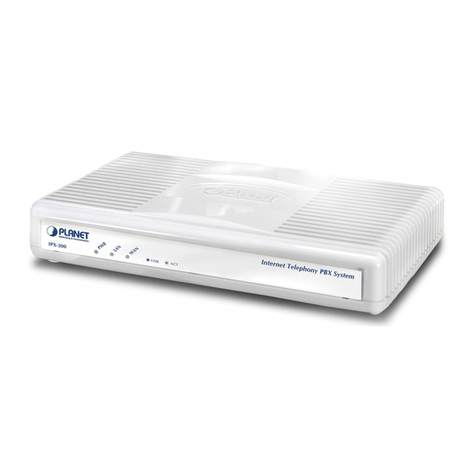
Planet
Planet Internet Telephony PBX System IPX-300 Series user manual
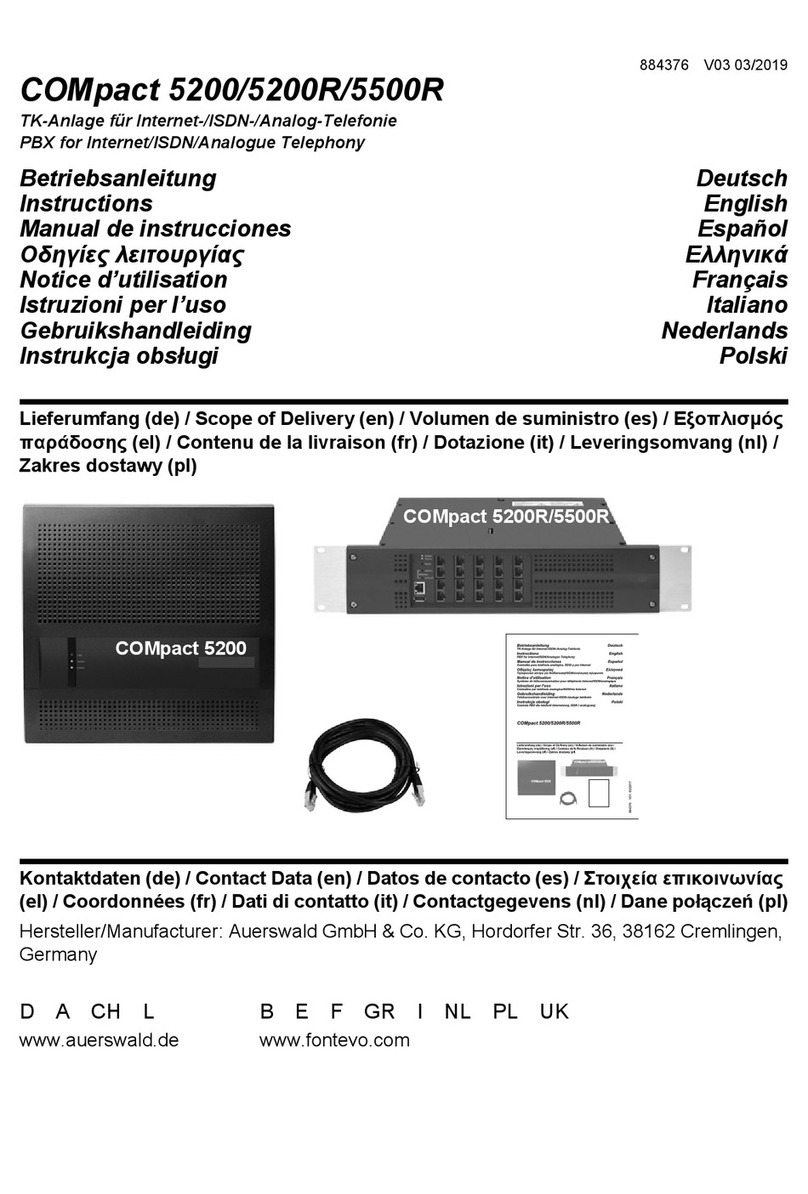
Auerswald
Auerswald COMpact 5200 instruction manual
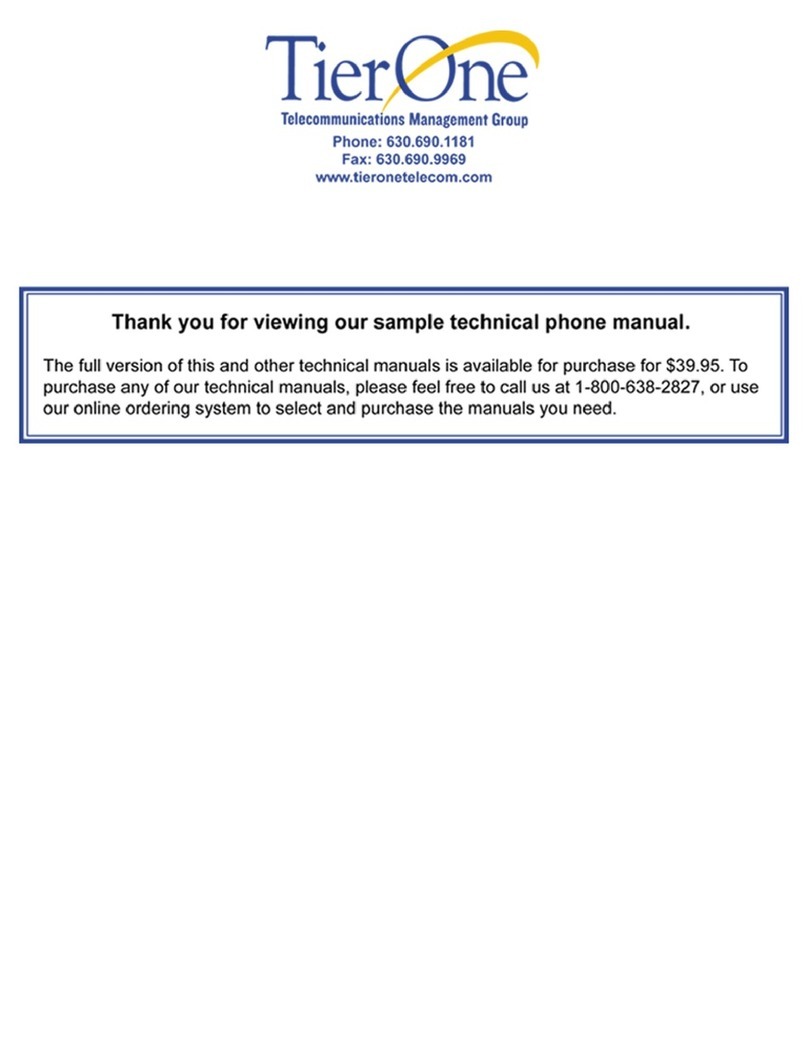
Panasonic
Panasonic KX-TVP200 installation manual
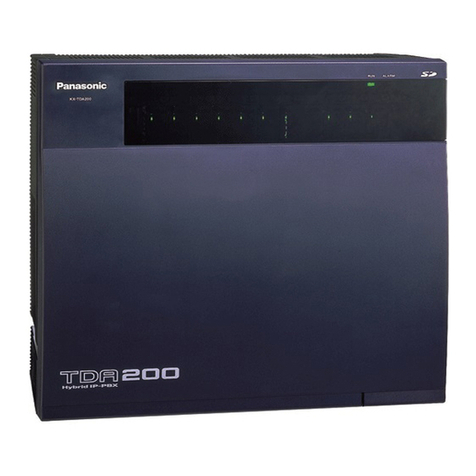
Panasonic
Panasonic HYBRID IP-PBX KX-TDA100 installation manual
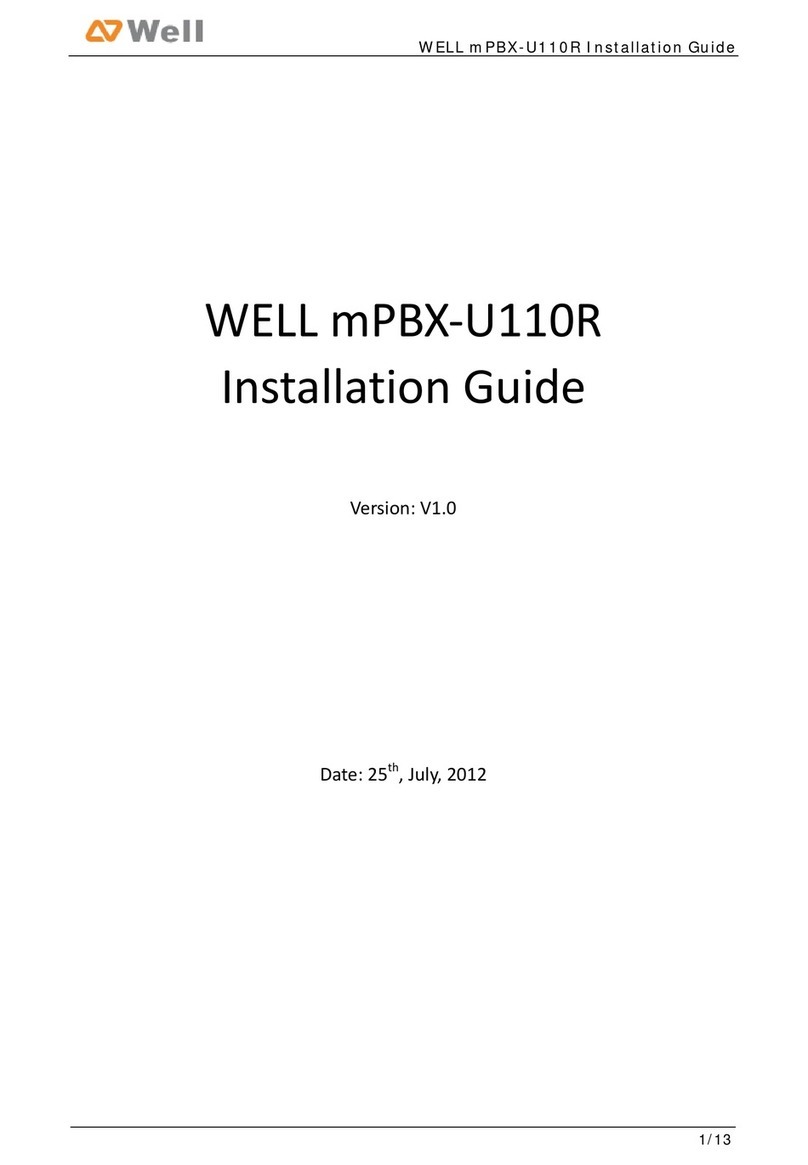
Well
Well mPBX-U110R installation guide
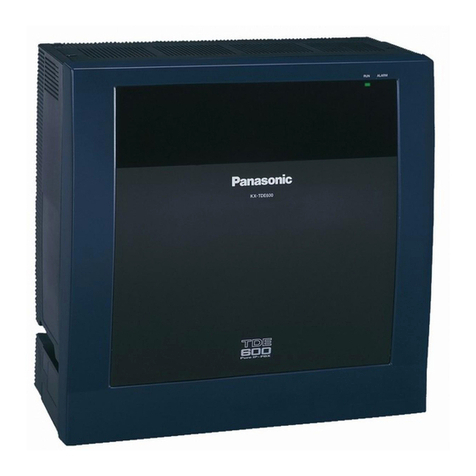
Panasonic
Panasonic KX-TDE100 Network guide
